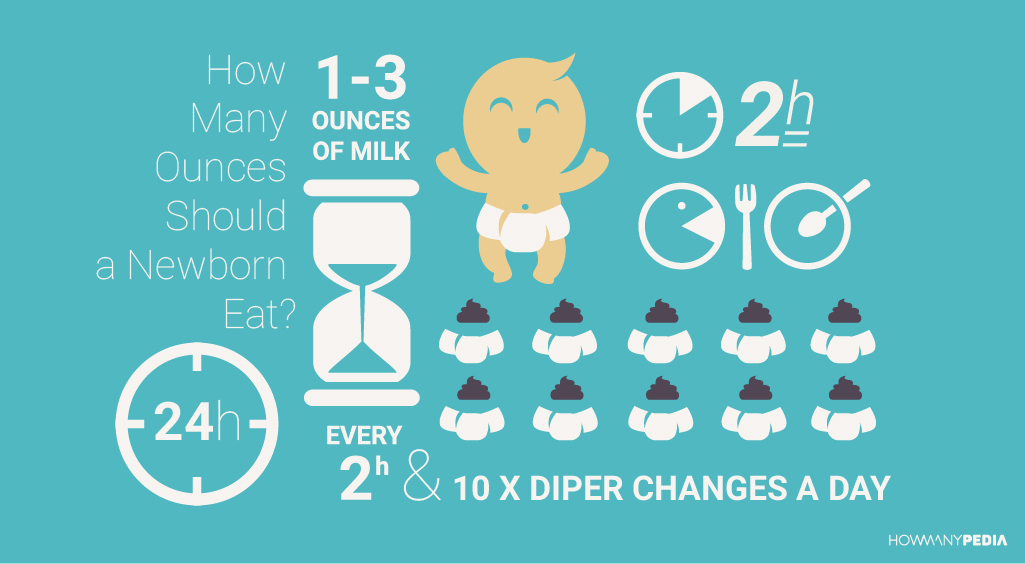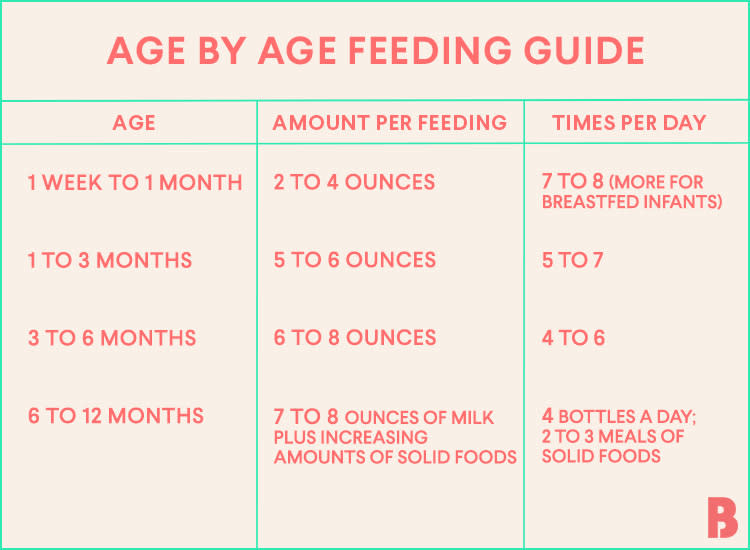Your formula-fed newborn will take from 2 to 3 ounces 6090 mL of formula per feeding and will eat every three to four hours on average during her first few weeks. Continue to offer breast milk or formula.
 How Much Formula Does Your Baby Need
How Much Formula Does Your Baby Need
Offer 25 ounces of formula per pound of body weight each day with a maximum of about 32 ounces daily.

How many ounces of formula should a newborn eat. Aim to feed Baby no more than 32 ounces of formula daily. For example if your baby weighs 10 lbs 45kg he must drinks 25 ounces 750ml a day. At about 2 months your baby may be taking 4-5 ounces 120-150 milliliters at each feeding and the feedings may be every 3-4 hours.
12 rows Formula fed infants typically need 2 12 ounces or 74 ml of formula for each pound of weight. By 8 months babies. As your baby nears their first birthday they should be eating a variety of foods and taking in about 4 ounces of solids at each meal.
Breastfed infants usually take smaller more frequent feedings than formula-fed infants. At the beginning youll need to test how much your child can eat. One to 2 ounces per feeding is usually enough early on but by the time your baby is 2 months old for example shell need 24 to 32 ounces.
After one month your babys stomach is about the size of a large egg with a capacity of 80-150 millilitres. This amount increases as your baby grows and is able to take more at each feeding. Never force your baby to eat extra formula or finish his bottle if hes full and dont leave him hungry until he or she cries.
From after the first week until around 6 months old when your baby starts weaning your little one may need around 150 to 200 millilitres of formula milk a. During the first 4 to 6 months when your baby isnt eating any solids heres a simple rule of thumb. Infants should drink breast milk andor formula for the first year of life.
For example if your baby weighs 6 pounds youll give her about 15 ounces of. On average a newborn drinks about 15-3 ounces 45-90 milliliters every 2-3 hours. As a rule of thumb infants under 6 months who havent yet started solids will take in 2 to 2 12 ounces of formula per pound of body weight within a 24-hour period.
The amount your formula-fed baby eats will depend on his weight age and appetite which can vary from one day to the next just like yours does. Babies eat about 2 ½ ounces 75 mL of formula a day per 1 pound 453g. Newborns start out with a stomach that can hold only a small amount at first.
Will take an average of 14-21 ounces of formula in a day. Then you will know the baseline and can adjust accordingly throughout the feedings. Begin offering breast milk andor formula in a cup starting at 6 months of age.
According to Infant Nutrition and Feeding babies should get five or more nursing sessions per day or 26 to 39 ounces oz of iron-fortified formula. After the first few days. A 4-month-old weighing 14 pounds needs 28-32 ounces.
When introducing juice offer 100 pasteurized juice and limit it to 46 ounces per day. Fill the bottle up to 3 or 4 ounces and see what the baby chooses to eat each time you feed it. A newborn weighing 7 lbs.
The quantity of formula your baby should have in a 24h period is between 870 ml and 1044 ml. How Much Formula Is Enough. A newborn baby should be generally fed between 1-3 ounces of milk each time they eat.
At this age each feed should consist of around 150 to 220 ml. Fruit juice is not recommended under 1 year of age. When breastfeeding they should eat anywhere from 4 to 8 ounces at each feeding.
Another way to express this rule of thumb is that the average baby takes 2 or 3 ounces of formula each day for every pound of body weight up to a maximum of 32 ounces.



